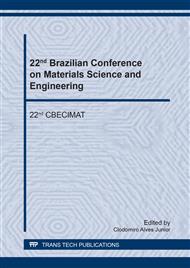[1]
A.C.F. Coriolano, A.A.A. Oliveira, R.A.F. Bandeira, V.J. Fernandes, A.S. Araujo: J Therm. Anal. Calorim. Vol. 119 (2015), p.2151.
Google Scholar
[2]
K.K.V. Castro, A.L. Figueiredo, A.D. Gondim, A.C.F. Coriolano, A.P.M. Alves, V.J. Fernandes, A.S. Araujo: J Therm Anal Calorim Vol. 117 (2014), p.953.
Google Scholar
[3]
A.C.F. Coriolano, C.G.C. Silva, M.J.F. Costa, S.B.C. Pergher, V.P.S. Caldeira, A.S. Araujo: Microp. Mesop. Mater. Vol. 172 (2013), p.206.
Google Scholar
[4]
S.H. Hu, S.C. Hu, Y.P Fu: Environ Prog Sustain Energ. Vol. 32 (2013), p.740.
Google Scholar
[5]
J.A. Cusidó, L.V. Cremades: Waste Manag. Vol. 32 (2012), p.1202.
Google Scholar
[6]
C. Martínez-García, D. Eliche-Quesada, L. Pérez-Villarejo, F.J. Iglesias-Godino, F.A. Corpas-Iglesias: J Environ Manag. Vol. 95 (2012), p. S343.
DOI: 10.1016/j.jenvman.2011.06.016
Google Scholar
[7]
D.F. Lin, C.H. Weng: J Environ Eng. Vol. 127 (2001), p.922.
Google Scholar
[8]
S.N. Monteiro, C.M.F. Vieira: Ceram. Int. Vol. 31 (2005), p.353.
Google Scholar
[9]
Associação Brasileira de Normas Técnicas. Cimento Portland com alta resistência inicial. Rio de Janeiro: ABNT 1990. (NBR 5733).
Google Scholar
[10]
Associação Brasileira de Normas Técnicas. Cimentos Portland resistentes a sulfatos. Rio de Janeiro: ABNT 1992. (NBR 5737).
Google Scholar
[11]
Associação Brasileira de Normas Técnicas. Concreto – procedimento para moldagem e cura de corpos de prova. Rio de Janeiro: ABNT 2015. (NBR 5738).
Google Scholar
[12]
M. Dondi, B. Fabbri, R. Laviano: Miner Petrogr Acta Vol. 35 A (1992), p.179.
Google Scholar
[13]
A.M. Segadães: Adv. Appl. Ceram. Vol. 105 (2006), p.46.
Google Scholar
[14]
F. Datchi, B. Mallick, A. Salamat, S. Ninet: Rev. Lett. Vol. 108 (2012), p.125701.
Google Scholar
[15]
M. Santoro, F.A. Gorelli, R. Bini, G. Ruocco, S. Scandolo, W.A. Crichton: Nature Vol. 441 (2006), p.857.
DOI: 10.1038/nature04879
Google Scholar
[16]
G. Mera, A. Navrotsky, S. Sen, H. Kleebe, R. Riedel: Journal of Materials Chemistry Vol. 1 (2013), p.3815.
Google Scholar
[17]
S. Sabyasachi, S.J. Widgeona, A. Navrotsky, G. Merac, A. Tavakolib, E. Ionescuc, R. Riedelc: Proceedings of the National Academy of Sciences Vol. 110 (2013), p.15904.
Google Scholar


